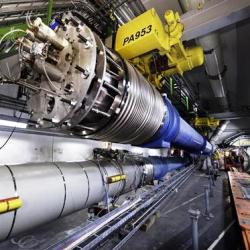C reative
Particle
Higgs
CPH Theory is based on Generalized light velocity from energy into mass.
CPH Theory in Journals
|
More Faults Found in LHC, But No Further Delay to Start-up
|
|
More Faults Found in LHC, But No Further Delay to Start-up
Written by Ian O'Neill
The LHC repairs are progressing well (CERN) In September 2008, the Large Hadron Collider (LHC) suffered a catastrophic quench, triggered by a faulty connection in the electronics connecting two of the supercooled magnets between Sections 3 and 4 of the 27 km-circumference particle accelerator. The "S34-incident" caused tonnes of helium coolant to explosively leak into the LHC tunnel, ripping the heavy electromagnets from their concrete mounts.
Naturally, this was a huge blow for CERN, delaying the first
particle collisions by several months. However, the repair work
is progressing well, and hopes are high for commencement of LHC
science as early as this summer. Now engineers are working hard
to avoid a recurrence of the S34 Incident, tracking down similar
electrical faults between the accelerator magnets. It
seems like they have found many more faults than expected… Ribbons of superconducting niobium-titanium wire is used by the LHC to carry thousands of amps of current to the magnets. Connecting the ribbon from electromagnet-to-electromagnet are splices that are soldered in place. Should one of these splices be weakened by poor soldering, an electrical short can occur, making the magnets lose superconductivity, initiating a quench, rapidly heating the sensitive equipment. Various sections are being re-examined and re-soldered. The good news is that this additional work is not compounding the delay any further.
Hopefully we'll see a second circulation of protons this summer, and according to informal rumours from a contact involved in the LHC science, the first particle collisions could start as early as October 2009. I will listen out for any further official confirmation of this information… Sources: CERN, Nature.com
Source: http://www.universetoday.com/2009/02/02/more-faults-found-in-lhc-but-no-further-delay-to-start-up/
Waiting for the Higgs Boson Elizabeth Kolbert on the Large Hadron Collider : To theorists, the tantalizing promise of the L.H.C. is that it will, finally, supply the evidence of “new physics” that they’ve been waiting for. Certain patterns of missing energy, for example, would suggest the existence of extra dimensions, as would the creation of mini black holes. Different results—also in the form of missing energy—would indicate the existence of squarks or other superparticles. There are good theoretical reasons to expect these phenomena to begin to appear at the energy level of the L.H.C., or so at least Arkani-Hamed tried to explain to me over several more espressos. He told me that he was completely confident the Higgs would be found at the collider: “I would bet many, many months’ salary.” He also said that if the Higgs was the only result, the L.H.C. would be a disappointment. “We theorists, we’re a hard lot to please. We’ve taken things for granted for so long we say, ‘Oh, yeah, for sure you’ll discover the Higgs.’ But the things we’re really interested in are all these major puzzles.” Brian Greene talks about the promise offered by LHC in finding the Higgs Boson:
It’s totally irrelevant, but I enjoyed the bad web design of the LHC site. Compare toNASA and Fermilab. Martin Schmaltz writes another introduction. Steven Hawking bets that people won’t find the Higgs boson, and that would make physics even more interesting. I get all gushy about big science, if only because it is completely beyond my comprehension. As I look through Wikipedia, it’s clear to me how often theoretical possibilities inspire great science fiction. (See also this). By the way, currently, LHC is down for repairs; expected to come online again in July 2009. Wikipedia says it might take up to 3 years to gather enough data to prove or disprove the existence of the Higgs boson. Joel Aschenbach defends basic science projects like LHC:
Source: http://www.imaginaryplanet.net/weblogs/idiotprogrammer/?p=83400287
1 2 3 4 5 6 7 8 9 10 Newest articles
|
|
Sub quantum space and interactions from photon to fermions and bosons |
Interesting articles
Since 1962 I doubted on Newton's laws. I did not accept the infinitive speed and I found un-vivid the laws of gravity and time.
I learned the Einstein's Relativity, thus I found some answers for my questions. But, I had another doubt of Infinitive Mass-Energy. And I wanted to know why light has stable speed?

